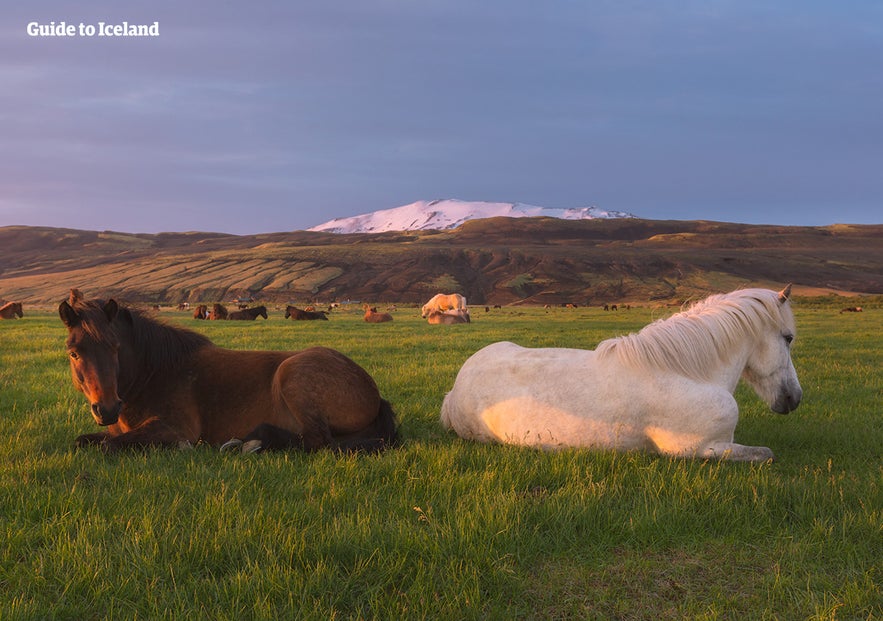
It has erupted twenty to thirty times since settlement and remains active to this day. Learn more about it on a volcano tour in Iceland.
Geography of Hekla
Hekla is located in the south of Iceland, just north of the country’s most famous volcano, Eyjafjallajökull, which last erupted in 2010, causing planes to be grounded and reporters to be tongue-tied for weeks. A dominant peak, standing at 1,491 metres tall (4,892 feet), it can be seen for miles around.
Miksi sisältöömme voi luottaa
Guide to Iceland on Islannin luotetuin matkailusivusto ja auttaa vuosittain miljoonia matkailijoita. Kaikki sisältömme on paikallisten asiantuntijoiden kirjoittamaa ja tarkastamaa – he tuntevat Islannin läpikotaisin. Voit luottaa siihen, että saat meiltä ajankohtaista, paikkansapitävää ja luotettavaa matkailutietoa.
Hekla is part of a 40 kilometre (25 mile) rift, the most active part, called Heklugjá, being under the volcano itself. There are many craters at the peak, two of which are known to erupt more than the others.
Unlike Eyjafjallajökull and Iceland’s other most active volcano, Katla, Hekla does not sit underneath any significant glacier, meaning its eruptions should not cause ash clouds to the same degree. In spite of this, some have been so great that the ash produced was still enough to change the climate of the northern hemisphere for years.
Hekla has also produced one of the greatest lava flows of this millenium of any volcano in the world, at eight cubic kilometres. Approximately 10 percent of Iceland’s landmass was brought up by lava from Hekla.
History of Hekla
The first recorded eruption at Hekla was in 1104, and it was so great and significant that it drew attention across Europe; the effects it had on the weather, on people’s breathing, and on agriculture lasted for years.
This, however, was not the first time it had done so; undiscovered by man, it had contributed to a third of all volcanic ash across northern Europe for the past seven millenia.
It would not significantly erupt again until 1300, although it had been recorded going off several times in between; one of the most notorious things about Hekla is its unpredictability, sometimes exploding within a decade of its last eruption, sometimes laying dormant for nearly a century.
For this reason, the farms around it were largely abandoned, partly explaining why today there are few settlements in Iceland’s south.
Further serious eruptions occurred in 1693 and 1845 with international consequences, but none as significant as the one that began in 1947. Lava bombs weighing over 20 kilograms (44 pounds) landed 32 kilometres away; some as large as 50 square metres (538 square feet) were thrown a kilometre. It took just 52 two hours before the enormous cloud of ash was covering Helsinki.
It would be thirteen months before the eruption stopped, ebbing and flowing with power, but constantly pouring ash into the atmosphere, poisoning crops and livestock.
It is likely many died of respiratory problems as a result, but Hekla even directly killed one person. A scientist filming the great lava flows from the crater, some of which were 15 metres (49 feet) tall, was struck by a block of lava.
Hekla erupted again in 1970 for two months, but since has only gone off for a few days at a time, in 1981, 1982, 1991 and 2000.
Though the 2000 one seemed inconsequential, it was later discovered that it proved that Hekla was even more frightening than was already thought. The remains of a pyroclastic flow, the most dangerous element of an eruption, where searing ash and rock travel at enormous speeds and raze all they meet, had occured for over five kilometres (three miles).
Hekla today

In spite of its volatile nature, Hekla can still be considered a safe place to visit; there are hiking opportunities all around it, and some tour operators embark in super jeeps journeys to its slopes. Visitors should not be afraid of the volcano’s potential, just aware of it.
Of course, before heading to Hekla if travelling without a guide, ensure you check the meteorological office’s website to ensure that there are no alerts that an eruption may be imminent. The volcano is monitored constantly.
In spite of this, Hekla remains as unpredictable as it ever was, and visitors are warned that in spite of every good measure, there is always a chance an eruption could start without being noticed.
Volcanologists also warn that it is overdue, and due to this volcano’s patterns, the warning time between knowing an eruption is imminent and it occurring will often be just an hour or less.









